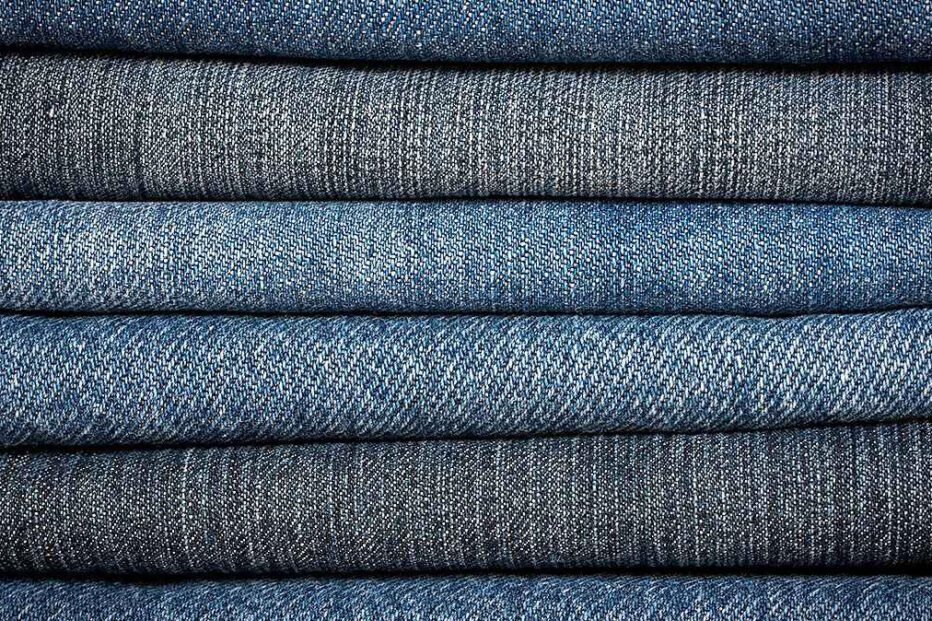Denim is a strong cotton warp-face textile where the weft runs under two or more warp yarns. This twill weave creates a diagonal ribbon that separates it from the cotton duck. Although a denim predecessor known as dungaree was produced in India for hundreds of years, denim itself was first produced in the French city of Nemes in Serge de Nemes.
Common Applications
Denim Jackets, Denim Shirts, Jeans, Dungarees, Skirts, Sneakers, Bags, Seat Covers

Description
A popular and casual indigo-dyed fabric most commonly used to make jeans
Denim is a strong cotton fabric made using a twill weave, which creates a subtle diagonal ribbing pattern. The cotton twill fabric is warp-facing, meaning that the weft threads go under two or more warp threads, and the warp yarns are more prominent on the right side. The diagonal ribbing is what makes denim fabric different from canvas or cotton duck, which is also a sturdy woven cotton fabric.
Background
Story
Denim was first produced in the city of Nîmes in France, and was originally called the serge de Nîmes. The word denim is an English colloquialism of the French term: “de nim.”
Denim became popular in the United States during the Gold Rush in 1853, when Levi Strauss opened up a shop in San Francisco selling dry goods along with buttons, threads, and canvas for tents. He began making durable pants for miners with big pockets for storing gold. Jacob Davis was one of Strauss’s customers, and he added copper rivets to the seams and pocket corners, adding strength. David and Strauss patented the pants and Strauss began mass producing and marketing them, helping them evolve from something worn exclusively by working men to a mainstream fashion item.
Manufacturing
After cotton fibers are harvested and spun into yarn, the yarns are dyed. The jeans are often indigo-dyed, making them the classic blue color for denim. Cotton denim is woven either on a shuttle loom or a projectile loom.
1. A shuttle loom produces what’s called selvedge denim. The weft thread is passed through the warp threads in a back and forth motion, with no breaks in the weft. This creates a very smooth and sturdy selvedge edge.
2. A projectile loom produces non-selvedge denim because there is a single weft thread for every row and not one thread woven throughout. This creates a more delicate edge that needs to be sewn to keep from fraying.

Expertises
Characteristic
- Long-lasting clothes.
- Helps to retain their shape.
- Helps protect against colour fading.
- Softer clothes.
- Fast-drying.
- Easier to iron.
- Freshly scented.
Denim fabric today
Denim fabric has remained in wide use in jeans since the 1850s. No other clothing item has endured within American culture like blue jeans, which makes that pair of Levi jeans in your closet something of a heritage artifact.
Over time, American textile producers started making other apparel items out of denim, and these days, you can even purchase home decor products made with this durable and aesthetically appealing fabric. While production of blue jeans was once limited to the United States, the late 20th-century manufacturing exodus saw the majority of denim production transfer overseas.
6 Different Types of Denim
- Indigo denim: Indigo denim is achieved by dying the warp threads with indigo dye and white threads are used as the weft. As a result, most blue jeans are blue on the right side, as the fabric is warp facing, and the interior is lighter blue, almost white.
- Stretch denim: Stretch denim weaves spandex or another elastic component to give the fabric some added give and flexibility. Stretch denim is often used for skinny jeans.
- Crushed denim: This type of denim has been treated so that it has a wrinkled look.
- Acid-wash denim: This denim is treated with chlorine and a pumice stone to create a marbled look.
- Raw denim: Raw or dry denim is fabric is that is not washed after it is dyed. This creates a rougher and stiffer texture.
- Sanforized denim: This is denim that is treated so that it doesn’t shrink in the wash. This applies to almost all kinds of denim except for raw denim.
Types of twill used for denim
There are different types of twill. For denim, the most common type of twill is 3×1 right hand twill (pronounced ‘three by one’).
‘3×1’ tells you that, on the fabric’s face (i.e. its front), you have three warp yarns for every weft yarn. Technically speaking, this means denim is warp-faced. It also explains why denim has diagonal lines in the fabric, known as twill lines.
‘Right hand’ tells you that the twill lines run from right to left on the face of the fabric.
Another type of twill weave you sometimes find in denim are 2×1 twill, where you have two warp yarns for every weft yarn. More commonly, though, is 3×1 left hand twill where the twill lines run from left to right.
There’s also broken twill, which was invented to prevent the fabric from pulling in the direction of the weave, which results in ‘leg twist.’
Social
12k followers
30k likes
Youtube
22k subscribers
8k followers
Have a project in mind?
If you have a great idea, reach out to me. Whether it is a small or big project, I will listen first and get back to you with a plan.

